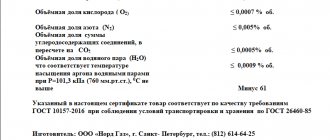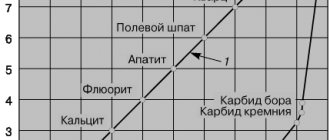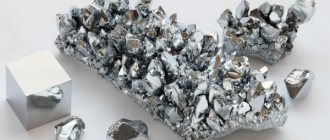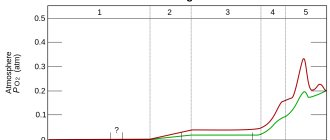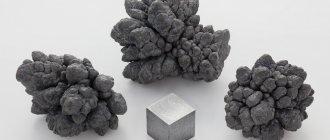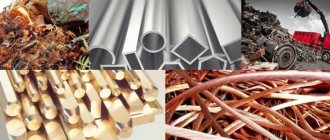Chemical element Ar
Ar is the 18th element of the periodic table, belonging to the noble inert gases. This substance is the third after N (nitrogen) and O (oxygen) in terms of content in the Earth's atmosphere. Under normal conditions, it is colorless, non-flammable, non-toxic, tasteless and odorless.
Other properties of argon gas:
- atomic mass: 39.95;
- content in air: 0.9% volume and 1.3% mass;
- density under normal conditions: 1.78 kg/m³;
- boiling point: -186°C.
The picture shows the name of the chemical element and its properties.
This element was discovered by John Strett and William Ramsay while studying the composition of air. The discrepancy in density in various chemical tests led scientists to believe that in addition to nitrogen and oxygen, there was an inert heavy gas in the atmosphere. As a result, in 1894, a statement was made about the discovery of a chemical element, the proportion of which in each cubic meter of air is 15 g.
Argon as the future of world medicine
Over the past 50 years in Russia there has been an increasing interest in the study and use of inert or noble gases for medical purposes. Xenon is called the “ideal anesthetic” and the “anesthetic of the 21st century” in many works. Its widespread use in anesthesiology is stopped only by its high price. Xenon is also being increasingly used for therapy; its effectiveness in many diseases has been proven.
There are several hypotheses trying to explain the effect of xenon on the human body and animals. Without going into details, let's just say that there are theories that try to explain the mechanism of action of xenon, based on its characteristics as a noble gas. This approach, which we also share, allows us to treat the entire group of noble gases as promising gases for use for medical purposes. And first of all, it is argon gas. It is average in atomic weight among the inert gases: He (4.00), Ar (39.95), Xe (131.29). It is the third most abundant gas in the atmosphere after nitrogen and oxygen, so it is cheap, its cost is almost 1000 times less than the cost of xenon. It should be noted that research on the use of inert gases began with argon; they tried to use it as an oxygen diluent for divers’ breathing mixtures. However, it turned out that at pressures above 3 atmospheres its anesthetic effect appears. This discovery later led to the idea of using xenon for anesthesia, because Calculations showed that xenon should have an anesthetic effect at atmospheric pressure. For divers, helium gas was selected as it does not give an anesthesia effect at any pressure. In 1999, a significant event for researchers of noble gases occurred - Russian specialists led by professor of medicine N.E. Burov. received permission to use xenon in medical practice in Russia. Unfortunately, this permission did not apply to other noble gases, so the number of studies in Russia on the use of xenon in medicine from that time began to differ significantly from the number of studies on other noble gases. But let us repeat, if xenon has a certain effect on the body, then with a high probability we should expect similar effects in other noble gases. One of the main abilities (besides the anesthesia effect) that has been discovered in xenon, and also in argon, is the ability of these gases to activate the production of the Hif-1 alpha protein in cells. Hif-1 alpha triggers the synthesis of many other biologically active proteins, including EPO (erythropoietin). And erythropoietin is the main protein that stimulates the regeneration of body tissues. This ability of noble gases explains many of their healing properties. Currently, injections of recombinant erythropoietin produced by mammalian cells are used in clinical practice. Their cost is high, but they are used due to their high efficiency. And noble gases encourage the body to produce its own erythropoietin, and in the case of argon, this own erythropoietin costs hundreds, or even thousands, less than injections. By the way, if you compare the amount of noble gases on earth and in space, it turns out that in space the content of noble gases is much higher than on earth. Argon as the future of world medicine This fact leads to the following hypothesis: Perhaps, when the content of noble gases exceeds the usual values, the body believes that some kind of cosmic penetration may have occurred, and a program to protect the body and the species as a whole is triggered? Reproduction and regeneration processes are activated.
One of the pioneers of the use of noble gases in medicine, professor of the Institute of Medical and Biological Problems, B.N. Pavlov. wrote: “Argon and helium are the future; the day will come when cylinders with these gases will appear in all clinics.”
At least, in addition to the production of erythropoietin, inhalation of inert gases, primarily argon and helium, gives a very powerful effect of increasing sexual function, this effect is observed in both sexes. It is clearly expressed in animals and humans. In animals, all researchers note an increase in the quantity and quality of offspring. In men, improvement and restoration of erectile function, in women, improvement in fertility. The effect is very powerful, it begins to work a day after inhalation, and lasts for a long time. Below is a list of diseases for which the effective effects of inhalation of noble gases have been identified: 1. Hypertension. The effect of reducing (normalizing) blood pressure was revealed. 2. Various types of otolaryngeal diseases. Otoprotective effect, improvement of blood supply to the nasopharynx. Effective treatment of respiratory diseases. 3. Improving capillary blood supply to the brain. 4. Improvement and restoration of potency, increased reproductive function. 5. Improving the general condition of the body, relieving stress. 6. Anti-inflammatory and immunoprotective effect. 7. Neuroprotective, in patients cerebral blood flow increases by more than 20%, as well as renal, hepatic, etc. blood flow 8. Radioprotective effect, xenon inhalations are used to restore vital organs after exposure to chemotherapy and radiotherapy. 9. Impact on the immune system, as a result, a decrease in the amount of drugs used, including antibiotics. Moreover, the list is far from complete, because... Research continues and this list continues to expand. But, unfortunately, all real clinical medical activity in Russia occurs only with xenon gas, because So far, only he has permission for use from the Pharmaceutical Committee of the Russian Federation. But this gas, as we have already mentioned, is the most expensive of all noble gases. And the cheapest is argon, and although its potential capabilities are slightly inferior to xenon, and in terms of price/quality ratio it is much ahead of xenon, it is still used in medicine only as a technical gas. Today in medical practice, argon is used as an inert gas for tissue coagulation. Here argon was also able to show itself in the best possible way. In Yekaterinburg, a caesarean section operation using argon plasma coagulation was developed and introduced into medical practice. The operation is almost bloodless. Rehabilitation time after childbirth is reduced by half, the number of complications has dropped fourfold. And because cells of a wound treated with argon actively begin to produce erythropoietin, tissue regeneration at the incision site occurs many times faster, pain is reduced and the suture dissolves faster. The suture resolves so well that after such an operation a normal birth is possible in the future. It is expected that this technology will be used in other types of surgical interventions. Let's return to anesthesia. According to international protocols (Copenhagen (1992), London, Montreal, Kyoto (1997), the production of anesthetics such as halothane, pentran, enflurane, isoflurane, containing carbon, chlorine and fluorine radicals should be suspended by 2030. An ideal anesthetic that has no negative effects , including in terms of ecology, is xenon, the only disadvantage is its price. Therefore, there is a high probability that for these purposes they will begin to use other, cheaper, noble gases argon or krypton, but the operation will have to be carried out using a pressure chamber, because the anesthetic effect of these gases occurs only at elevated pressure.Also, noble gases, and in particular argon gas, as the most accessible of them, can be used in the treatment of infectious and viral diseases, and they may well become either a replacement for antibiotics, or can significantly reduce their use. There are studies on the effects of xenon inhalation on the influenza virus with very encouraging results. There is a published and patented result on the treatment of hepatitis C using this technology using xenon gas. More than 30 people have already been cured using this technology. The author of this article has recorded cases of curing severe cases of sinusitis in three inhalation procedures, and healing infected purulent wounds in four inhalations. By the way, industrial animal husbandry today is impossible without the use of antibiotics, which then reach humans through food. The task of replacing antibiotics in industrial livestock farming has been long overdue, but so far it has not been possible to solve it. We need an effective and cheap way to massively increase the resistance of animal organisms. Potentially, argon could be just such a means. One of the pioneers of the use of noble gases in medicine, professor of the Institute of Medical and Biological Problems, B.N. Pavlov. wrote: “Argon and helium are the future; the day will come when cylinders with these gases will appear in all clinics.” I would like to continue this phrase: “In all clinics in Russia and the world.”
AUTHOR OF THE ARTICLE: Alexey Vitalievich Bobrovnikov, head of the MedGazProm Group of Companies
How is argon produced?
Ar does not change during its use and always returns to the atmosphere. Therefore, scientists consider this source to be inexhaustible. It is extracted as a by-product when air is separated into oxygen and nitrogen through low-temperature rectification.
To implement this method, special air separation devices are used, consisting of high- and low-pressure columns and a condenser-evaporator. As a result of the rectification (separation) process, argon with small impurities (3-10%) of nitrogen and oxygen is obtained. To perform purification, impurities are removed using additional chemical reactions. Modern technologies make it possible to achieve 99.99% purity of this product.
Installations for the production of this chemical element are presented
Argon gas is stored and transported in steel cylinders (GOST 949-73), which are gray in color with a stripe and a corresponding green inscription. In this case, the process of filling the container must fully comply with technological standards and safety rules. Detailed information about the specifics of filling gas cylinders can be read in the article: cylinders with welding mixture - technical features and operating rules.
Methods for producing argon
Argon is the third most common gas in the earth's atmosphere, so the most logical way is to extract it from the air. For this purpose, special low-temperature distillation devices are used.
The process of separating the inert substance is carried out in the following sequence:
- The air is cleared of dust and compressed to a liquid state.
- Liquid air, consisting mainly of oxygen, nitrogen and argon, undergoes rectification.
- After nitrogen is separated from the liquid obtained during compression, the oxygen-argon mixture is purified.
The boiling point of argon in the distillation unit is minus 185.3˚C. At the same time, oxygen boils at a temperature 3 degrees higher, and nitrogen – 13°C lower than this indicator. Due to the slight difference in the transition from one state of aggregation to another, at the first stage of argon separation the mixture contains a large amount of liquid oxygen. At the final stage of argon production, the noble gas is separated from the oxygen-argon mixture. The post-treatment process is usually carried out using electrolytic hydrogen. As a result of the reaction in the contact apparatus with oxygen, water vapor is formed, which is then utilized through a moisture separator.
Argon can be obtained not only from atmospheric air. In some manufacturing processes, this gas may be a by-product. For example, in the production of ammonia, argon is an admixture of nitrogen and is a completely unnecessary element, therefore the gas thus obtained has a very low cost compared to cryogenic argon.
Where is argon gas used?
This element has a fairly wide scope of application. Below are the main areas of its use:
- filling the internal cavity of incandescent lamps and double-glazed windows;
- displacement of moisture and oxygen for long-term storage of food products;
- extinguishing agent in some fire extinguishing systems;
- protective environment during the welding process;
- plasma-forming gas for plasma welding and cutting.
In welding production, it is used as a protective medium in the process of welding rare metals (niobium, titanium, zirconium) and their alloys, alloyed steels of various grades, as well as aluminum, magnesium and chromium-nickel alloys. For ferrous metals, as a rule, a mixture of Ar with other gases is used - helium, oxygen, carbon dioxide and hydrogen.
Type of protective environment during the welding process created by argon
Being heavier than air, the argon jet reliably protects the metal during welding. The inert gas provides protection for a molten and heated metal surface for a long time. Read more about the welding process using an argon protective environment in the article: argon welding - technology and operating modes of equipment.
Story
The history of the discovery of argon begins in 1785, when the English physicist and chemist Henry Cavendish, studying the composition of air, decided to determine whether all the nitrogen in the air was oxidized. For many weeks, he exposed a mixture of air and oxygen in U-shaped tubes to an electric discharge, as a result of which new portions of brown nitrogen oxides were formed, which the researcher periodically dissolved in alkali. After some time, the formation of oxides stopped, but after binding the remaining oxygen, a gas bubble remained, the volume of which did not decrease with prolonged exposure to electrical discharges in the presence of oxygen. Cavendish estimated the volume of the remaining gas bubble to be 1/120 of the original volume of air. Cavendish could not solve the mystery of the bubble, so he stopped his research and did not even publish its results. Only many years later, the English physicist James Maxwell collected and published Cavendish's unpublished manuscripts and laboratory notes.
The further history of the discovery of argon is associated with the name of Rayleigh, who devoted several years to studying the density of gases, especially nitrogen. It turned out that a liter of nitrogen obtained from the air weighed 1.6 mg more than a liter of “chemical” nitrogen (obtained by decomposing some nitrogenous compound, for example, nitrous oxide, nitrous oxide, ammonia, urea or saltpeter) (the weight of the first was is equal to 1.2521, and the second is 1.2505 g). This difference was not so small that it could be attributed to experimental error. In addition, it was constantly repeated regardless of the source of chemical nitrogen.
Having not come to a solution, in the fall of 1892, Rayleigh published a letter to scientists in the journal Nature, asking for an explanation for the fact that depending on the method of nitrogen release, he received different density values. The letter was read by many scientists, but no one was able to answer the question posed in it.
The already famous English chemist William Ramsay also did not have a ready answer, but he offered Rayleigh his cooperation. Intuition prompted Ramsay to suggest that the nitrogen in the air contains admixtures of an unknown and heavier gas, and Dewar drew Rayleigh’s attention to the description of Cavendish’s ancient experiments (which had already been published by this time).
Trying to isolate a hidden component from thin air, each of the scientists went their own way. Rayleigh repeated Cavendish's experiment on an enlarged scale and at a higher technical level. A transformer energized at 6,000 volts sent a sheaf of electrical sparks into a 50-liter bell filled with nitrogen. A special turbine created a fountain of spray of alkali solution in the bell, absorbing nitrogen oxides and carbon dioxide impurities. Rayleigh dried the remaining gas and passed it through a porcelain tube with heated copper filings, which retained the remaining oxygen. The experiment lasted several days.
Ramsay took advantage of his discovery of the ability of heated magnesium metal to absorb nitrogen, forming solid magnesium nitride. He repeatedly passed several liters of nitrogen through the device he had assembled. After 10 days, the volume of gas stopped decreasing, therefore, all the nitrogen was bound. At the same time, by combining with copper, oxygen, which was present as an impurity in nitrogen, was removed. By this method, Ramsay managed to isolate about 100 cm³ of new gas in his first experiment.
So, a new element was discovered. It became known that it is almost one and a half times heavier than nitrogen and makes up 1/80 of the volume of air. Ramsay, using acoustic measurements, found that the molecule of the new gas consists of one atom - such gases had never been encountered in a stable state before. A very important conclusion followed from this: since the molecule is monatomic, then, obviously, the new gas is not a complex chemical compound, but a simple substance.
Ramsay and Rayleigh spent a lot of time studying its reactivity towards many chemically active substances. But, as one might expect, they came to the conclusion: their gas is completely inactive. It was stunning - until then, no such inert substance had been known.
Spectral analysis played a major role in the study of the new gas. The spectrum of the gas released from the air, with its characteristic orange, blue and green lines, was sharply different from the spectra of already known gases. William Crookes, one of the most prominent spectroscopists of that time, counted almost 200 lines in its spectrum. The level of development of spectral analysis at that time did not make it possible to determine whether the observed spectrum belonged to one or more elements. A few years later, it turned out that Ramsay and Rayleigh were holding in their hands not just one stranger, but several - a whole galaxy of inert gases.
On August 7, 1894 in Oxford, at a meeting of the British Association of Physicists, Chemists and Naturalists, a report was made on the discovery of a new element, which was named argon
. In his report, Rayleigh stated that in every cubic meter of air there is about 15 g of open gas (1.288 wt.%). The fact that several generations of scientists did not notice the component of air, and even in the amount of a whole percent, was too incredible! In a matter of days, dozens of natural scientists from different countries tested the experiments of Ramsay and Rayleigh. There was no doubt: the air contains argon.
Ten years later, in 1904, Rayleigh received the Nobel Prize in Physics for his studies of the densities of the most common gases and the discovery of argon, and Ramsay received the Nobel Prize in Chemistry for his discovery of various inert gases in the atmosphere.
origin of name
At the suggestion of Dr. Medan (chairman of the meeting at which the report on the discovery was made), Rayleigh and Ramsay gave the new gas the name “argon” (from the ancient Greek ἀργός - lazy, slow, inactive). This name emphasized the most important property of the element - its chemical inactivity.


